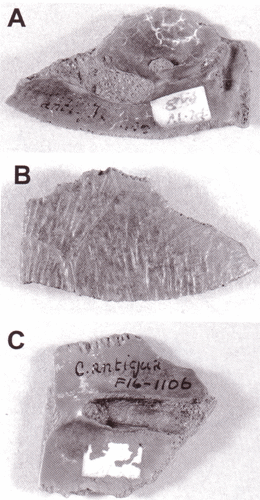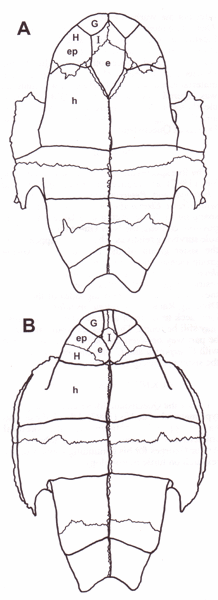| |

Fig. 3. Ventral and dorsal photographs of Rheodytes devisi, the ventral views showing the parallel sutural edges and low angle of the anterior bridge strut. A-B) Holotype QMF16-1106B; C) Paratype QMF16-1106C.
Chelodina insculpta de Vis, 1897
Material. Holotype: none set (de Vis, 1897). Lectotype: QMF1109a by subsequent designation (Gaffney, 1981) (Fig 4). Paralectotypes: QM F16-1107, F1109b-g by subsequent designation (Gaffney, 1981).
Horizon. Pliocene or Pliestocene
Locality. Darling Downs, Queensland, Australia, restricted (this study).
Discussion. Material consists of: QM F16-1107 (Fig. V in de Vis, 1897), numerous carapace fragments including parts of pleurals and peripherals. Most of these are not particularly diagnostic. There is a partial articulated 6th and 7th pleural from the left side that has characters diagnostic of Chelodina. The fragment listed as D in de Vis' figure five is actually a 7th pleural not a 6th. QM F1109a-g (Fig. VI in de Vis, 1897), various plastral units which can clearly be diagnosed as Chelodina using the lectotype, 1109a (Gaffney, 1981). This would appear, however, to represent at least two animals as sutural surfaces are preserved yet there is no match between the anterior and posterior halves of the plastron.
The material available is diagnosable to genus using the scute sulci arrangements of the lectotype, an entoplastron in which there is clearly a large intergular which is separated from the margin anteriorly by the gulars a unique feature of the Chelodina (Gaffney, 1981)(Fig. 5). There is further evidence of generic assignment from the relative widths of the anterior and posterior parts of the posterior lobe of the plastron and from the positioning of the pelvic suture on pleural seven of the carapace.
Chelodina insculpta possessed a large, robust bridge strut, a character unique to the C. expansa group of species (Thomson, in press; Thomson et al., in press.). Further, this specimen had a large carapace excluding many species from the C. expansa group, such as C. rugosa, which have a reduced margin. However, the margin is not as flared at the posterior or as wide as C. expansa. Therefore, C. insculpta is recognised as a valid taxon.
The locality data for this species was originally given as a combination of the Darling Downs, Queensland; Warburton River, South Australia; and Eight Mile Plains near Brisbane, Queensland (de Vis, 1897. In the original description de Vis states that the Warburton material was not figured and consisted of seven carapace fragments, as the name bearing lectotype is an entoplastron this rules out the Warburton River as a type locality. There is no mention of Eight Mile Plains until the locality section of the paper and de Vis clearly states that "in addition to the fragments of carapace figured, sixteen others from the Darling Downs ...". It seems clear that despite other material examined only Darling Downs material was figured. As the lectotype (QMF1109a) is clearly identifiable in figure VI of de Vis (1897) I am restricting the type locality to the Darling Downs of Queensland. |
|
The locality data for this species was originally given as a combination of the Darling Downs, Queensland; Warburton River, South Australia; and Eight Mile Plains near Brisbane, Queensland (de Vis, 1897. In the original description de Vis states that the Warburton material was not figured and consisted of seven carapace fragments, as the name bearing lectotype is an entoplastron this rules out the Warburton River as a type locality. There is no mention of Eight Mile Plains until the locality section of the paper and de Vis clearly states that "in addition to the fragments of carapace figured, sixteen others from the Darling Downs ...".
It seems clear that despite other material examined only Darling Downs material was figured. As the lectotype (QMF1109a) is clearly identifiable in figure VI of de Vis (1897) I am restricting the type locality to the Darling Downs of Queensland.

Fig. 5. Comparison of the intergular region of A) Chelodina rugosa and B) Elseya dentata showing the difference between the Chelodina and Short-necked Chelid conditions. Lower case refers to bones, upper case to scutes. G = gular, H = humeral, I = intergular; e = entoplastron, ep = epiplastron, h = hyoplastron.
Acknowledgments
I would like to thank the Queensland Museum for loan of the type material of de Vis (1897). I would like to thank all those who have supplied specimens for the skeletal collection at the University of Canberra. Lastly I wish to thank Arthur Georges for his continuing support of my research on turtle morphology.
Literature Cited
|
|


